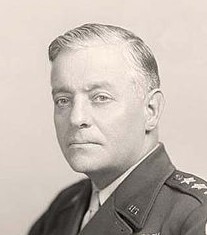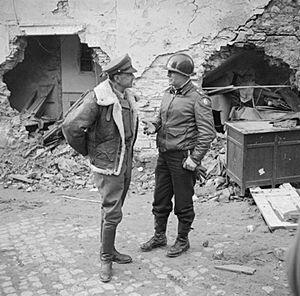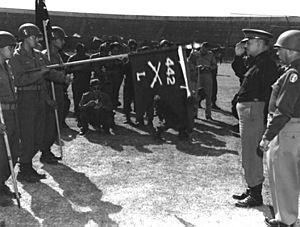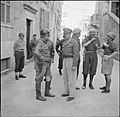Lucian Truscott facts for kids
Quick facts for kids
Lucian Truscott Jr.
|
|
|---|---|
 |
|
| Born | January 9, 1895 Chatfield, Texas, US |
| Died | September 12, 1965 (aged 70) Alexandria, Virginia, US |
| Allegiance | United States |
| Service/ |
United States Army |
| Years of service | 1917–1947 |
| Rank | General |
| Commands held | Third United States Army Fifth United States Army Fifteenth United States Army VI Corps 3rd Infantry Division 5th Cavalry Regiment |
| Battles/wars | World War I World War II |
| Awards | Distinguished Service Cross Army Distinguished Service Medal (3) Navy Distinguished Service Medal Legion of Merit Purple Heart |
| Relations | Lucian Truscott IV (grandson) |
| Other work | Central Intelligence Agency – senior agent Germany, later Deputy Director for Coordination Author |
General Lucian King Truscott Jr. (January 9, 1895 – September 12, 1965) was an important United States Army officer during World War II. He was known for his bravery and leadership. From 1943 to 1945, he led several large groups of soldiers. These included the 3rd Infantry Division, VI Corps, Fifteenth Army, and Fifth Army. He was one of only two U.S. Army officers to command a division, a corps, and an army in battle during the war.
Contents
Early Life and Joining the Army
Lucian King Truscott Jr. was born in Chatfield, Texas, on January 6, 1895. He grew up mostly in Oklahoma. When he was 16, he pretended to be 18 to get into teacher training. He taught school for a while before joining the United States Army in 1917.
He joined the army during World War I. Truscott applied for officer training, again saying he was older and had more education than he did. In October 1917, he became a second lieutenant in the Cavalry Branch. During the war, he stayed in the United States. He helped patrol the border with Mexico.
On March 27, 1919, Truscott married Sarah Nicholas "Chick" Nicholas Randolph. They had three children: Mary, Lucian King, and James Joseph.
Military Career Between Wars

Between World War I and World War II, Truscott worked in different cavalry and staff jobs. He completed the Cavalry Officers Course and later taught at the Cavalry School. He also graduated from the United States Army Command and General Staff College and taught there too. In the early 1930s, he led a troop of soldiers in the 3rd Cavalry Regiment.
World War II Service
In 1942, Truscott, who was now a colonel, helped create a special American commando unit. This unit was inspired by the British Commandos. Truscott, who was promoted to brigadier general in June 1942, activated this unit as the 1st Ranger Battalion.
In May 1942, Truscott joined the Allied Combined Staff. In August, he watched the Dieppe Raid. This raid was mainly a Canadian operation. A small group of American Rangers also took part. This was the first time American troops fought against German forces in World War II.
In November 1942, Truscott, now a major general, led 9,000 soldiers in landings in Morocco. This was part of Operation Torch, led by Major General George S. Patton.
Leading the 3rd Infantry Division
Truscott took command of the 3rd Infantry Division in March 1943. He prepared them for the Allied invasion of Sicily, called Operation Husky. He was known as a very tough trainer. He made the 3rd Infantry Division very strong and ready for battle. At 48, he was one of the youngest division commanders in the U.S. Army.
He led the division in the attack on Sicily in July 1943. His training paid off. The division moved very fast over the mountains. Their special marching pace was called the 'Truscott Trot'. They would march five miles per hour for the first mile, then four miles per hour. This was much faster than the usual pace. The 3rd Infantry Division was seen as one of the best-trained divisions.
After a short break, the division landed in Italy in mid-September. They fought their way up the Italian peninsula. They crossed the Volturno Line in October and fought in harsh winter weather around the Gustav Line. The division suffered many losses and was then pulled out for rest.

The Battle of Anzio
In January 1944, Truscott's division attacked Anzio as part of the U.S. VI Corps. This operation was planned to go around the German defenses in Italy. However, the corps commander decided not to push inland right away. Truscott's 3rd Division soon faced fierce fighting. They suffered heavy losses as the Germans tried to push the Allies back into the sea.
Because of the difficult situation, Truscott was made the deputy commander. After the corps commander was removed on February 17, Truscott was given command of the VI Corps. He was 49 years old, making him one of the youngest corps commanders. His commander, General Clark, later wrote that Truscott was "a quiet, competent, and courageous officer with great battle experience."
After Anzio, Truscott continued to lead VI Corps through the fighting in Italy. His corps helped in the final Battle of Monte Cassino and captured Rome.
Operation Dragoon in France
After Italy, Truscott's corps was moved to prepare for Operation Dragoon. This was an attack by sea on southern France. On August 15, 1944, VI Corps landed in southern France. They faced little resistance at first. The German army retreated quickly, allowing the Allies to advance fast. This led to cutting off and capturing many German soldiers. The forces from Dragoon met up with forces from Operation Overlord (the Normandy landings) in mid-September.
The port of Marseille in southern France was very important for supplies. The fast Allied advance in Europe slowed down in September 1944 because of a lack of supplies. Marseille and its railways were repaired and became a major supply route. They provided about one-third of the supplies the Allies needed for their push into Germany.
On September 2, 1944, Truscott was promoted to lieutenant general. In October, he became commander of the new Fifteenth Army. This army was mostly for training and administration.

Truscott's next command was in December 1944. He was promoted to lead the U.S. Fifth Army in Italy. He led the Fifth Army through the tough winter of 1944–1945. Many of his troops were in exposed positions in the Italian mountains. He then led the army through the final Allied attack in Italy, which destroyed the German forces there.
After the War
After World War II, Truscott took command of the Third Army from General George S. Patton in October 1945. He led it until April 1946. This command included the U.S. occupation zone in Germany. Truscott retired from the army on September 30, 1947.
In 1954, Congress promoted several World War II officers who had done jobs bigger than their rank. As an army commander, Truscott had done the duties of a four-star general. So, the 1954 law promoted him to general on the retired list.
Truscott also wrote two books: Command Missions (published in 1954) and The Twilight of the U.S. Cavalry (published after his death in 1989).
Work with the CIA
In 1951, Truscott joined the Central Intelligence Agency (CIA). His official job was "Special Consultant," but his real role was the senior CIA representative in Germany. He was in charge of secret operations in Europe. This information became public only in 1994.
In 1953, President Eisenhower approved Truscott's appointment as the CIA's Deputy Director for Coordination. This meant Truscott helped manage the CIA's growing network of agents around the world. His duties included helping with plans to change governments in Iran and Guatemala. Truscott was involved in planning Operation PBSuccess, a CIA mission to remove the president of Guatemala.
Truscott left the CIA in 1958. He did not write about his CIA work in his books or papers.
Death and Legacy
Lucian Truscott Jr. passed away on September 12, 1965, in Alexandria, Virginia. He was buried at Arlington National Cemetery. In 1966, Truscott Hall, a building at the United States Army War College, was named after him. In 2012, Truscott was honored in his hometown of Chatfield, Texas.
Personality
Truscott had a very rough voice, said to be from accidentally swallowing acid as a child. He was a bit superstitious about his clothes. He often wore a leather jacket, "pink" pants, and lucky boots in combat. He also wore a white scarf as his special sign, starting in Sicily.
Truscott once told his son, "You play games to win, not lose. And you fight wars to win. That's spelled W-I-N!"
His soldiers respected him. People noted that he was not boastful. He was humbled by the sacrifices of those who served under him. A famous cartoonist, Bill Mauldin, described how Truscott spoke at a military cemetery in Italy. He turned his back on the important people and quietly spoke to the crosses, apologizing, then walked away.
Awards and Medals
Truscott received many awards for his bravery. He earned the Distinguished Service Cross, the U.S. Army's second-highest award for valor. He received it for his actions in Sicily on July 11, 1943. His other awards include the Army Distinguished Service Medal (three times), the Navy Distinguished Service Medal, the Legion of Merit, and the Purple Heart.
Images for kids
-
General Sir Harold Alexander with Major General Lucian Truscott and other senior Allied commanders at Anzio, Italy, May 5, 1944.



